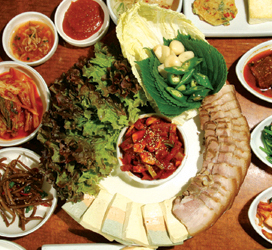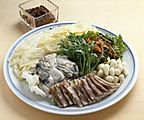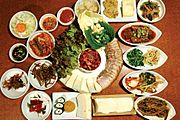Bossam facts for kids
 |
|
| Place of origin | Korea |
|---|---|
| Associated national cuisine | Korean cuisine |
| Main ingredients | Pork shoulder, belly, or hand |
| Korean name | |
| Hangul |
보쌈
|
|---|---|
| Hanja |
褓-
|
| Revised Romanization | bossam |
| McCune–Reischauer | possam |
| IPA | [po.s͈am] |
Bossam (보쌈) is a yummy Korean dish. It's made with pork shoulder that's boiled with spices. The pork is then sliced into thin pieces.
You eat Bossam with lots of tasty side dishes. These often include spicy radish salad, fresh garlic slices, and ssamjang (a special dipping sauce). You also get saeu-jeot (salted shrimp) and kimchi.
The fun part is wrapping everything! You use ssam (wrap) vegetables like lettuce, kkaennip (perilla leaves), and napa cabbage leaves. You put the meat and side dishes inside the leaf and eat it all together. That's why Bossam means "wrapped" or "packaged"!
Bossam is a very popular dish in South Korea. People often enjoy it as anju, which means food eaten with drinks.
The Story of Bossam
Bossam has a cool history linked to a big Korean tradition called gimjang. This is when families make huge amounts of kimchi to store for winter. It's a lot of hard work!
Long ago, during the Joseon era, rich families called yangban (scholar-gentry) wanted to make sure their workers were happy. So, they would give them a pig for a feast.
The workers would boil the pork and eat it with the freshly made kimchi. This new kimchi was still crunchy and fresh. It was a perfect match for the soft, boiled pork. This tradition is how Bossam became a favorite dish.
How to Make Bossam
While you can use beef, most people prefer pork for Bossam. Pork neck is often chosen because it's less fatty than pork belly. This makes the dish lighter.
To prepare the meat, it's tied with string to keep its shape. Then, it's boiled in a special broth. This broth has many ingredients to make the pork taste great and reduce any strong smell.
Some common ingredients in the broth are star anise, ginger, scallion (the white part and root), garlic, and doenjang (a type of soybean paste). Sometimes, coffee powder or tea leaves are added too!
Once the pork is cooked, it's rinsed with cold water. The string is removed, and the meat is gently pressed in a cloth. This helps it keep its shape.
When the meat cools down, it's sliced into thin pieces, about 0.3 centimeters thick. It's then served with all the delicious side dishes. These usually include spicy radish salad (like a kimchi filling) and fresh napa cabbage leaves.
If fresh raw oysters are served with the meat, the dish gets a special name: gul-bossam (굴보쌈). This means "oyster bossam."
Gallery
-
Bossam table with banchan (side dishes)
See also
 In Spanish: Bossam para niños
In Spanish: Bossam para niños




